Cisco CCNP ROUTE Implementing a Scalable Multiarea Network OSPF Based Solution
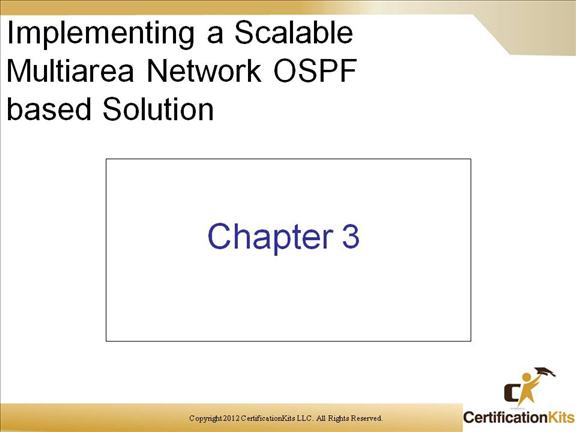
Cisco CCNP ROUTE Objectives
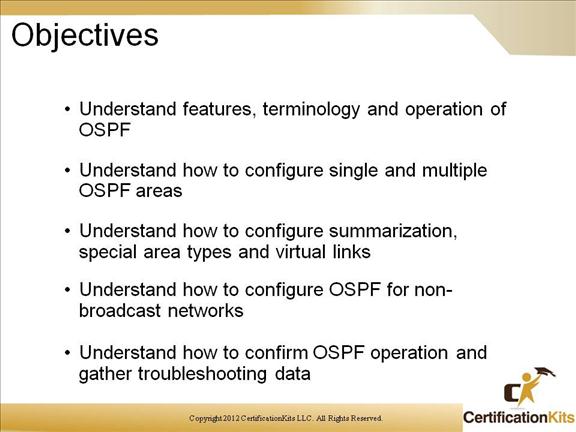
Cisco CCNP ROUTE Open Shortest Path First
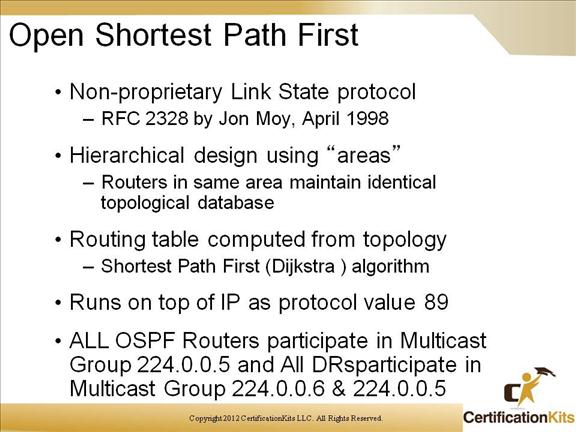
If you remember, we discussed link state routing protocols and identified that they require more administration. This design administration requires that all OSFP routers are configured in a hierarchical area design.
RIP & IGRP use the Bellman-Ford algorithm to find their best route, OSPF uses the Dijkstra algorithm to find the shortest path to remote networks.
OSPF uses protocol value 89 in the IP packet.
OSPF communicates through the use of multicast packets.
All OSPF routers participate in multicast group 224.0.0.5
All OSPF designated routers (DR & BDR) participate in 224.0.0.5 as well as 224.0.0.6
Cisco CCNP ROUTE Why OSPF?
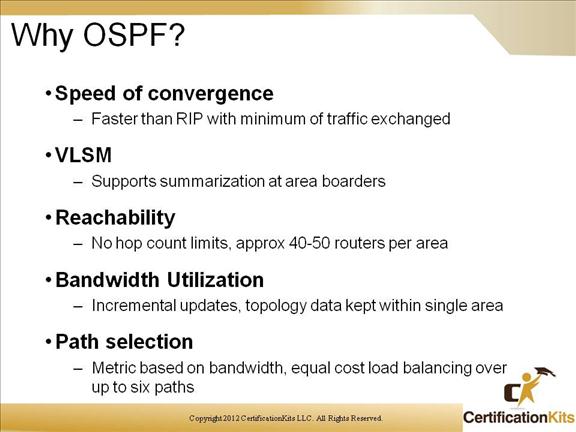
OSPF was developed to combat the limitation of RIP.
OSPF is a LINK STATE Routing protocol that has these following characteristics
Speed of convergence
Faster than RIP with minimum of traffic exchanged
VLSM
Supports summarization at area boarders
Reachability
No hop count limits, approx 40-50 routers per area
Bandwidth Utilization
Incremental updates, topology data kept within single area
Path selection
Metric based on bandwidth, equal cost load balancing over up to six paths
Cisco CCNP ROUTE OSPF Areas
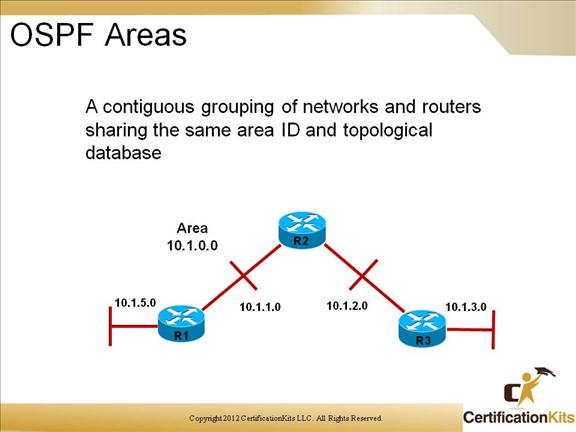
- • Identified by a 32 bit field
- • Manually configured
- • If only one area exists, it’s ID can be ANY number
- • If more than one area is defined, area 0 must exist and is the backbone
- • Area 0 must be connected to all other areas
- • There is only one area 0
Cisco CCNP ROUTE OSPF Terminology
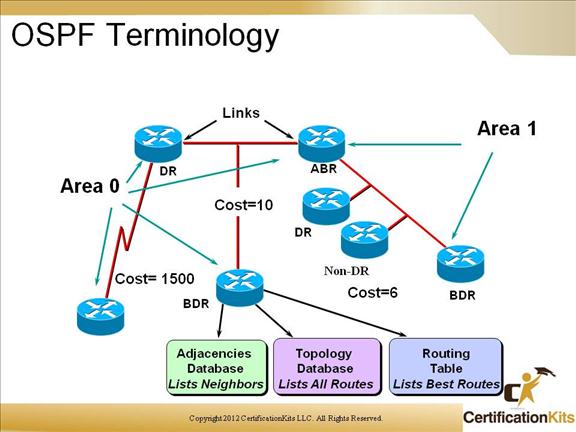
Link – Interface on a router
Link-state – Status of a link between two routers
Includes a router’s interface and its relationship to its neighboring routers
Cost – Indication of the overhead required to send packets across an interface
High bandwidth = low cost
Area – A contiguous grouping of networks and routers sharing the same Area ID and topology database
DR (Designated Router) – An elected router in Broadcast and Non-Broadcast environments that is adjacent to all other OSPF routers
BDR (Backup Designated Router) – An elected router in Broadcast and Non-Broadcast environments that is adjacent to all other OSPF routers
that will promote it self if the Designated Router is no longer available
Neighborship Database – Listing of all the neighbors to which a router has established bi-directional communication
Link State/Topological Database – List of information about all other routers in the same area
Routers in the same area have identical link state databases
Routing Table – Generated when the SPF algorithm is run on the link-state database
Each router has a unique routing table
Cisco CCNP ROUTE OSPF Terminology
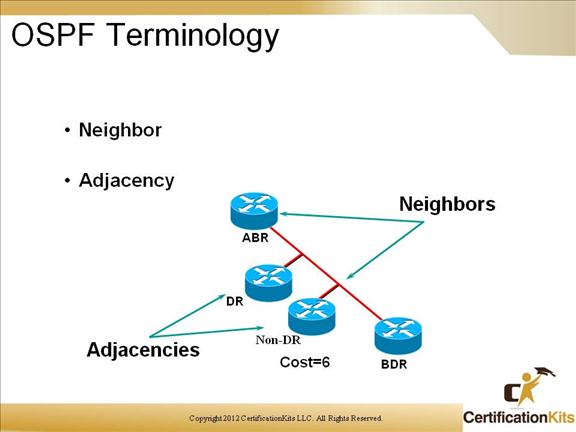
Neighbor
Two routers that have an interface on a common network
Usually discovered by hello’s but can also be configured administratively
Adjacency
Relationship formed between selected neighbors in which routing information is exchanged. Not all neighbors are adjacent
Only Broadcast and Non-Broadcast network types have Designated and Backup Designated Routers!!!
Cisco CCNP ROUTE OSPF DR and BDR
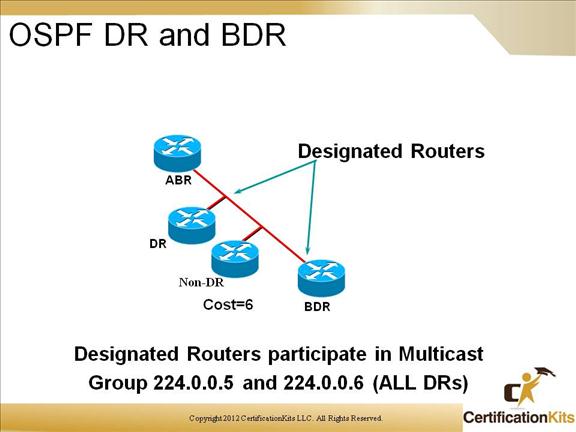
- •Elected routers that coordinate the flow of route updates within a subnet
- • All routers on a sub-net form adjacencies with the DR and BDR
- • Clients send updates to the DR and BDR only
- • The DR informs all other clients of changes in topology
- • BDR assumes DR role if DR fails but performs no DR functions if DR remains available
- • It is generally not a good idea to select the same router to be designated router on many LANs simultaneously.
- • ONLY Broadcast and Non-Broadcast Network types have Designated and Backup Designated Routers.
Cisco CCNP ROUTE Electing the DR and BDR
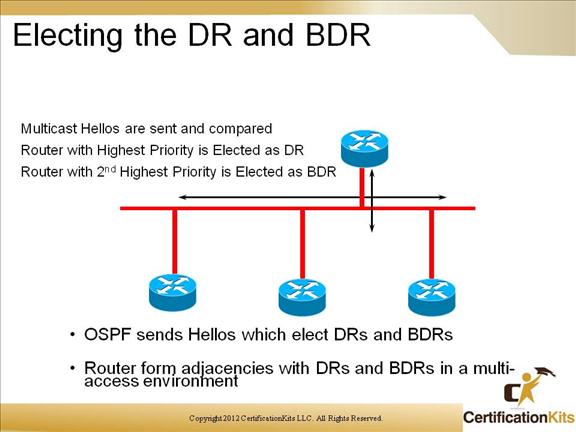
The following outlines the process OSPF takes and rules that are followed when electing a Designated Router:
- • Routers elect a DR and BDR per network
- • All routers set by default to priority 1 (0-255)
- • Priority of zero (0) means router can not be elected as a DR
- • Router with highest priority wins BDR (1 – 255), if no other router has a higher priority the BDR will then become the DR
- • RouterID breaks tie, Router ID is either the Highest Loopback or Highest Configured IP address on any given active interface
- • If DR fails, BDR promoted to DR and a new BDR is elected
- • Existing DR will not be overthrown if “better” router is turned on after initial election
- • DRs and BDRs listen to multicast traffic on both multicast address 224.0.0.5 and 224.0.0.6 224.0.0.6 is exclusively listed to by DRs
Cisco CCNP ROUTE Router ID (RID)
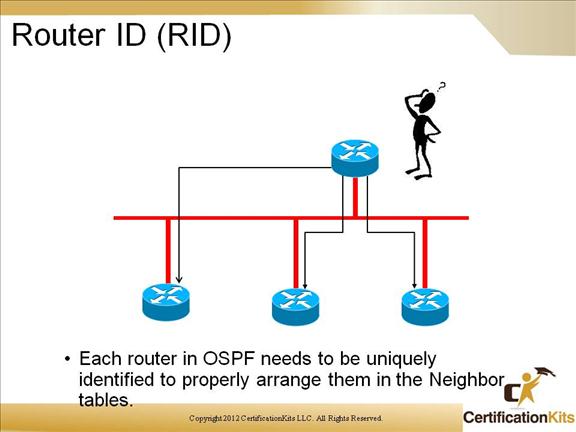
Each router that is participating in OSPF needs to be uniquely identified. The method of identification that OSPF uses is Router IDs (RID).
32 bits that uniquely identifies an OSPF router
Highest IP address in router is RouterID
Overridden by Loopback interface if present
Even if Loopback address has lower value
Recommended to use loopback interface
Easier to manipulate this number
Always up
Interface loopback 0
Ip address 10.1.1.1 255.255.255.0
You can also Statically assign the Router ID in the OSPF router configuration mode:
(config)# router ospf 1
(config-router)# router-id
Do NOT use same loopback address on different routers
Cisco CCNP ROUTE Modifying OSPF operation

Router(config-if)# ip ospf priority {0 – 255}
Change the priority of a router on an interface
0 means to not participate in election
1 is default, 255 is highest priority
Router(config-if)# ip ospf cost
Change the cost of an interface
Default cost is 100,000,000/bandwidth
10Mbps Ethernet = 10
100 Mbps Ethernet = 1
Can be used to ensure that two routers use the same cost to refer to the same interface. Ex. Nortel’s default cost for 10MBPS link is 1
r3(config-if)# ip ospf priority 10
r2# sho ip ospf neighbor detail
Neighbor 10.1.30.1, interface address 10.1.23.3
In the area 0 via interface Ethernet0
Neighbor priority is 10, State is FULL, 6 state changes
DR is 10.1.23.3 BDR is 10.1.23.2
Options 2
Dead timer due in 00:00:37
r2(config)# int s0
r2(config-if)# ip ospf cost 1000
r2# show ip route
10.0.0.0/8 is variably subnetted, 5 subnets, 3 masks
O 10.1.10.1/32
C 10.1.12.0/30 is directly connected, Serial0
O 10.1.30.1/32 [110/11] via 10.1.23.3, 00:00:13, Ethernet0
C 10.1.23.0/24 is directly connected, Ethernet0
C 10.1.20.0/24 is directly connected, Loopback0
r2#
Cisco CCNP ROUTE ip ospf cost
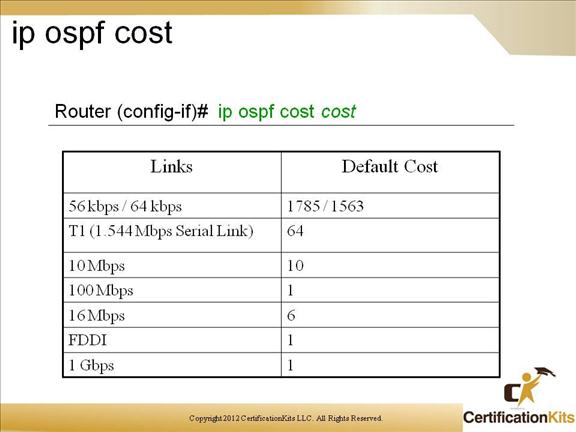
COST is 1 to 65535. In general, the path cost in Cisco routers is calculated using the formula 108/bandwidth. The following are the cost associated with OSPF using the default cost metrics.
56 kbps / 64 kbps = 1785 / 1563
T1 (1.544) = 64
10 Mbps = 10
100 Mbps = 1
16 Mbps = 6
FDDI = 1
1 Gbps = 1
Cisco CCNP ROUTE Types of OSPF Routers
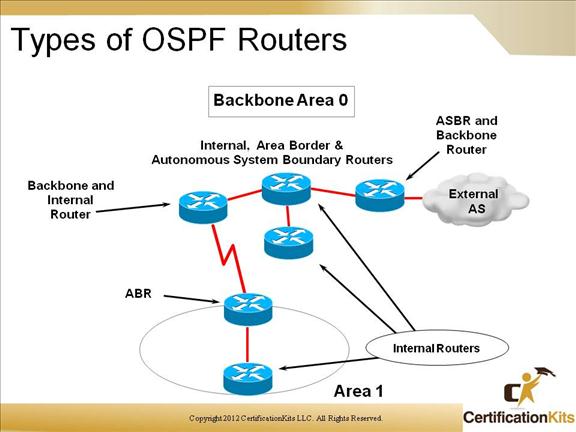
Internal Routers:
All interfaces reside inside same area
Area Border Routers:
One interface in each of two areas
Backbone Routers:
At least one interface resides in Area 0
AS Boundary Routers:
One interface resides in a non-OSPF area
Cisco CCNP ROUTE Planning for OSPF
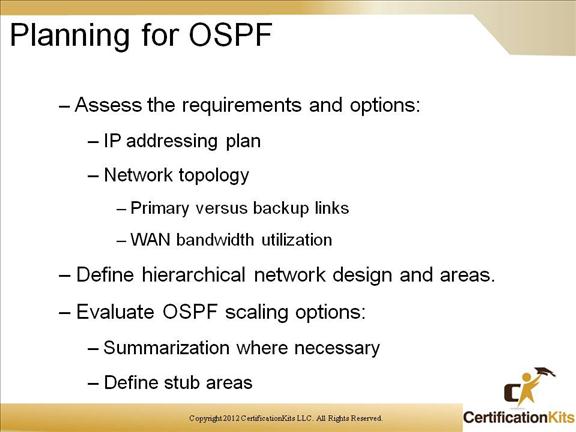
Since OSPF is hierarchical in nature, coming up with an OSPF design to include not only an IP Address plan but also defining OSPF areas to include types in key. As such, OSPF implementation depends on the specific needs and topology. When planning an OSPF design you must gather information about your topology. Examples are as follows:
- • IP Address usage.
- • Network topology (e.g. Connected links)
- • Design of multiple OSPF areas as it makes sense.
Cisco CCNP ROUTE OSPF Implementation Plan
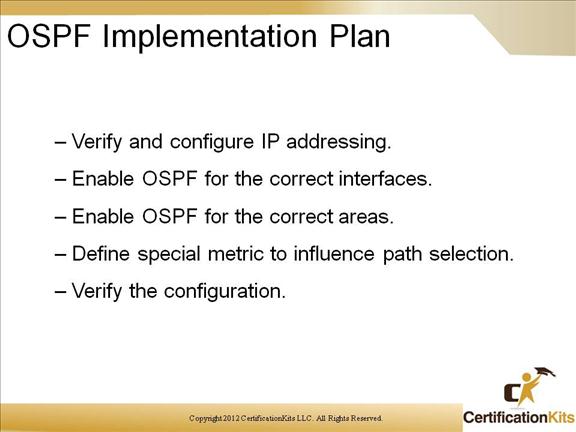
Once you has compiled your requirements, it is time to create an Implementation Plan. Key pieces developing an Implementation Plan are as follows:
- • Define IP Networks that need to be included (advertised) by OSPF.
- • Enable OSPF on the correct interfaces or with the correct network statement under the OSPF routing process
- • Verify OSPF is enabled within the correct area
- • Specify any metrics if you want to change the default behavior of OSPF.
- •After implementation is complete, verify everything is working as expected.
